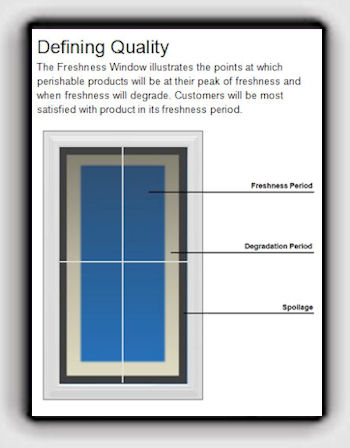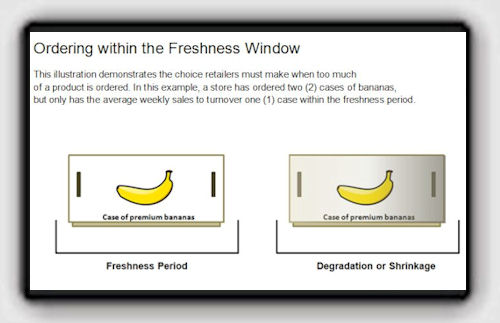|
|


The Freshness Window
Understanding Perishable Sales
Submitted by Adam Smith, CFE, CFI
Senior Regional
Asset Protection Manager
Winn Dixie Stores
Each day companies around the world engage in the sale
of perishable goods, which are like a ticking clock that
counts down to a point when the product must be sold or
the product will be lost. The most common perishable
goods purchased by consumers are fresh foods sold by
grocers. Another common perishable good is live plants.
These goods have individual spoilage timelines; if not
met, will result in losses.
Perishable goods have a freshness period of a number of
days from harvest, which vary by specific item. In this
freshness period, the product is considered at its peak
quality regardless of the point within the freshness
period. After the freshness period ends, quality
degrades by each passing day. For example, a banana one
day beyond its freshness period is considered much
fresher than a banana four days beyond its freshness
period. During the degradation period, customers will be
increasingly dissatisfied with the quality of the
product. If too many days pass beyond the freshness
period, the product becomes spoiled. At the point of
spoilage, passing days are irrelevant. Fresh foods
illustrate this point best, but the concept is
applicable to perishable goods following the described
model.
 The freshness period and the spoilage point vary by
product. As an example, fresh lettuce may have a
freshness period of 7 days and a spoilage point of 14
days. In days 8-13, the quality of the product will
slowly degrade to the point of spoilage. Ideally, this
product should be sold between days 1 and 7.
Alternatively, onions have a larger freshness period. The freshness period and the spoilage point vary by
product. As an example, fresh lettuce may have a
freshness period of 7 days and a spoilage point of 14
days. In days 8-13, the quality of the product will
slowly degrade to the point of spoilage. Ideally, this
product should be sold between days 1 and 7.
Alternatively, onions have a larger freshness period.
The period up to spoilage represents the Freshness
Window. The point when product is sold within the
Freshness Window represents the level of quality a
customer will experience. Providing products within the
freshness period is a way for retailers to add value to
perishable goods without increasing costs.
Alternatively, selling beyond the freshness period
reduces the value of perishable goods. Companies
providing goods within the freshness period will have
the highest customer satisfaction relating to quality.
Best-in-class operators will continuously evaluate and
discard products early in the Freshness Window. On the
other hand, struggling companies will be offering
products later in the Freshness Window, up to the point
of spoilage. Customers purchasing products late in the
Freshness Window will have a limited amount of time to
use the product before spoilage occurs. In many cases, a
good operator will throw product away at a point in the
Freshness Window that the poorly run operation would
still have available for sale. In this scenario,
customers of the poorly run retailer are eating the
equivalent of the competitor’s garbage.
Shrinkage Paradox
If freshness is such a huge opportunity, why do
companies leave product on the shelf outside of its
freshness period? The problem is rooted in the Shrinkage
Paradox. Shrinkage is the losses that occur from
discarding product. Some companies have intense pressure
to reduce losses resulting from shrinkage. This pressure
is frequently misinterpreted by line-level managers.
Often times, the line-level manager interprets reducing
shrink as keeping product available for sale longer. By
doing so, product is kept on the shelf past the
freshness period into degradation.
Every retailer of perishable goods has a tolerance of
the amount of shrink they will allow. Perishable grocers
typically allow anywhere from 5%-8% of total perishable
sales. As pressure to reduce shrinkage is increased,
most companies inadvertently expand their Freshness
Window to allow product more time on the shelf to
potentially be sold. This will reduce shrinkage slightly
to achieve desired levels. However, these efforts are
limited to the spoilage point of the product, because
the shelf life cannot be extended beyond it.
Opening the Freshness Window to reduce shrinkage will
only provide small and temporary reductions. By opening
the Freshness Window into degradation, customers will be
dissatisfied, and some will shop competitors. This
strategy will ultimately backfire due to the loss of
sales. The loss of sales will cause an increase in
shrinkage as a percentage to total sales. This is the
position of poorly run perishable operations.
Alternately, retailers with good operations will
continuously evaluate and throw out products that do not
meet their freshness standards. The quality of discarded
products from well run operations are much higher than
poorly run operations; however, these well run
operations will have shrinkage near poorly run
operations. Paradoxically, both operations will have
similar shrinkage figures, which ignore the quality of
product discarded. This will cause many to falsely
assume that both retailers have comparable operational
efficiencies.
The Root Cause
Shrinkage is normally higher in poorly run operations;
however, the real issue is the type of product
discarded. The true sign of a well run operation is the
freshness of the product available for sale. The
difference lies in how fresh the product being thrown
out it is, which is what compromises shrinkage. Good
retailers throw out product within the freshness period
before it begins to degrade. Fresher product increases
sales and customer satisfaction.
Selling product within its freshness period requires the
retailer to have sales to turn over the product within
said period. As sales increase, this becomes easier.
Assuming the freshness period for bananas is 7 days, a
retailer must average selling a case of bananas per week
in order to sell a case ordered within its freshness
period. Problems occur when a retailer orders more
perishable product than its average weekly sales
support. In this example; if the retailer sells one case
of bananas per week, ordering two cases will cause a
problem. At this point, a decision has to be made to
take a loss by throwing the product away or keep the
product available for sale past the freshness period.
 Shrinkage is merely a symptom of poor ordering and
planning. The root cause of the issue is ordering too
much product. This notion is difficult to grasp for
some; precisely, because proper ordering is complex.
When selling perishable goods, the best information is
often in the form of projections. In the case of
industrial production, factories can place just-in-time
orders for a small group standardized parts. In a
grocery store, there are hundreds of perishable
products, which can come from different areas of the
world depending on the growing season. Each of these
products has a unique Freshness Window. This task can be
daunting; especially, considering the limited amount of
sales and inventory data available. Shrinkage is merely a symptom of poor ordering and
planning. The root cause of the issue is ordering too
much product. This notion is difficult to grasp for
some; precisely, because proper ordering is complex.
When selling perishable goods, the best information is
often in the form of projections. In the case of
industrial production, factories can place just-in-time
orders for a small group standardized parts. In a
grocery store, there are hundreds of perishable
products, which can come from different areas of the
world depending on the growing season. Each of these
products has a unique Freshness Window. This task can be
daunting; especially, considering the limited amount of
sales and inventory data available.
To a lesser extent, other procedures such as "cold
chain" can similarly reduce the freshness of perishable
products. Cold chain is a procedure to keep products at
required storing temperatures during transportation,
which can occur when a store receives product and when a
store moves product from storage into selling areas. If
perishable products are allowed to lose temperature
during this time, quality is reduced corresponding to
the amount of time without temperature control. Here
again, following these procedures serves to maintain the
quality of product that has already been purchased; not
doing so, decreases the value of the goods.
Quality Costs
Many retailers selling perishable goods choose to look
the other way as it relates to shrinkage, so long as the
number is within their tolerance. These companies are
falsely assured by their shrinkage figure being near the
industry average. However, as mentioned earlier, the
product thrown out (shrinkage) can vary in terms of
quality. The real issue concerns the quality of product
that is available for sale.
In a highly competitive industry, quality of goods is a
significant differentiator. Especially, considering that
improvements in quality can come at no additional cost
to the company. The goal is to maintain the freshness of
the product that has already been purchased, which is
accomplished by proper ordering. Ironically, few
retailers commit resources to improve this operational
area of their business. Perhaps, the Shrinkage Paradox
is masking their perception of the problem or the
organization does not truly understand the impact of the
problem.
Nevertheless, quality has a significant impact on
customer satisfaction. In a recent survey conducted by
the Food Marketing Institute in 2010, customers noted
product quality as the second leading consideration in
selecting a grocery store, which was only 2% less than
the leading consideration of price. In 2008, as part of
the same survey, customers identified product quality as
the leading selection criteria. As economic pressures
relax, retailers can expect product quality to take
center stage with customers.
Building a Structure
for Quality
Addressing the quality issue is not simple. Sales serve
as a feedback loop for product quality, so poorly run
operations will struggle most because of fewer sales.
Since products are sold by cases and packs, a retailer
needs enough sales to cover at least the smallest
quality available to be ordered within the freshness
window; anything else will be shrinkage. Increasing
quality will improve customer satisfaction, leading to
sales; however, there will be a lag period. In the
meantime, accepting the unsold product at the end of the
freshness period as shrinkage will be difficult.
Consumer demand for variety will add to this pressure,
because many niche varieties have low sales.
Complicating the ordering problem is the absence of good
sales data from these products. Some retailers stock
hundreds of different perishable goods, all of which
have a unique Freshness Window. Companies rarely have
item specific data regarding amount sold, ordered, and
discarded; if they do, the data is rarely uniform
between each measurement. This type of data is
instrumental in measuring each product’s Freshness
Window against the amount of inventory on hand.
Retailers need to know where their inventory levels
relate to the Freshness Window at all times. Reporting
on this metric will uncover ordering issues which may be
causing poor quality products to be sold. Understanding
which products have the largest freshness opportunity
will allow for strategic focusing on the problem.
Additionally, the retailer will be able to use this data
to measure the impact their Freshness Window is having
on sales, which may justify investments in training or
technology.
In some cases, a product may be identified as having
unavoidable shrink. Unavoidable shrink may be caused by
average sales within the freshness period that do not
cover the amount of product in a case or pack. Under
these circumstances, the retailer can choose to accept
the losses in order to provide variety for its
customers. If this option is chosen, the retailer should
keep track of all unavoidable shrinkage and include it
in budgets. In some cases, it may be possible to work
with suppliers to reduce case size to accommodate the
Freshness Window of the product. This would not be
possible without having the granular data to identify
these opportunities. As a last resort, a retailer may
choose to eliminate the product from its offerings.
By attacking the quality issue at its root, retailers
can improve the quality of perishable goods they have
available to their customers, without increasing costs.
An increase in quality will lead to an increase in
customer satisfaction, which will increase total sales.
Sales increases will allow the retailer to consider
stocking a larger variety of products that would not be
profitable at a lower sales volume. Retailers may need
to invest in new technology in order to capture the data
needed to develop successful freshness strategies. In
highly competitive industries, quality strategies are
critical to delivering exceptional value to customers. |
|
|
What's Happening?
Coming in 2012:
Keyword/Phrase Search
Research Capability
Mobile App's
LP Show Coverage
The Top 10
 |
|